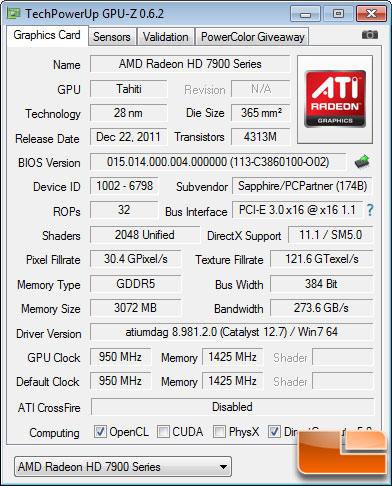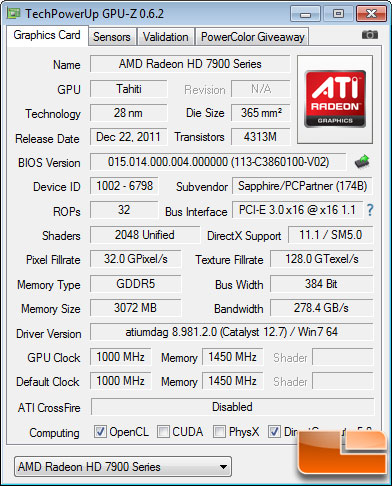Sapphire Radeon HD 7970 OC 3GB Video Card Review
SAPPHIRE HD 7970 OC 3GB
The SAPPHIRE HD 7970 OC 3GB GDDR5 graphics card is said to be one of the best AMD Radeon HD 7970 graphics card on the market today, so when we were able to get one in for testing we couldn’t say no. The SAPPHIRE HD 7970 OC 3GB stands out from the crowd with a factory overclock and a custom GPU cooler that looks awesome. This card doesn’t have just one factory overclock though as SAPPHIRE loaded up two BIOS versions on this card and both feature different clock frequencies! The first offers a mild overclock of 950MHz on the core and 1425MHz on the memory and the other is more aggressive at 1000MHz on the core and 1450MHz on the memory. AMD just last week announced the AMD Radeon HD 7970 GHz Edition, but cards like the SAPPHIRE HD 7970 OC 3GB have already been running at or above the 1GHz mark for many months now.

Just taking a quick glance at the SAPPHIRE HD 7970 OC 3GB you should be able to see that this card uses dual-extractor cooling technology or Dual-X for short. This GPU cooler has 5 massive copper heatpipes topped with dual 90mm axial-flow fans to run quiet during normal operating conditions, yet still handle the heat when under full load. The fan shroud is made from plastic, but it is solid feeling when you pick it up and hold the card.

Sapphire currently offers three AMD Radeon HD 7970 cards, so their product stack isn’t too confusing to understand. You have a standard clocked card available with the AMD reference design cooler or the Sapphire Dual-X GPU cooler. You then have the top end card that has the Dual-X GPU cooler and it comes with the core and memory clocks factory overclocked.
Sapphire Radeon HD 7970 Video Cards:
- Sapphire Radeon HD 7970 3GB (21197-00-40G) – 925MHz Core Clock
- Sapphire Radeon HD 7970 3GB Dual-X(11196-02-40G) – 925MHz Core Clock
- Sapphire Radeon HD 7970 3GB Dual-X OC Version (11197-01-40G) – 950MHz/1000MHz Core Clock

Turning the Sapphire HD 7970 OC Edition video card over you can see that it doesn’t have a back plate or any of the GDDR5 memory chips on the back of the black colored PCB. The serial number sticker is the most important thing that is located on the back of this card. This number is critical if you plan on ever RMA’ing it under the 2-year limited warranty period should anything ever go wrong. The PCB of
the card measures ~10.50″ in length and stands at ~4.75″ in height. It
should be
noted that the black plastic fan shroud extends past the PCB, so the true length
of the card is ~11.25″ in length. Sapphire is using PCB model number 109-C38637-00 in case you are curious or want to know what water blocks are compatible.

With the video card flipped upside down you can better see the five copper heatpipes that help keep the ‘Tahiti XT’ GPU nice and cool. The Dual-X cooling solution is one of the more impressive GPU coolers that we have seen.

The SAPPHIRE Radeon HD 7970 OC has a pair of mini-DisplayPort 1.2
connectors, a full size HDMI 1.4a output for 3D video (Blu-ray 3D)
support, and a dual-link DVI-I when it comes to video outputs. The AMD
Radeon HD 7900 series supports up to six DisplayPort displays by
“daisy chaining” them to two mini-DisplayPort outputs.

The SAPPHIRE Radeon HD 7970 OC 3GB has two CrossFire interconnects and you can link up to four of these cards together for improved performance. Like many other Radeon HD 7970 cards that we have seen in the past, SAPPHIRE is using the BIOS switch and the card has two BIOS versions on it. On the OC edition that we are reviewing here today, the second BIOS is pre-programmed to allow a higher maximum overclock and more aggressive fan profile.
SAPPHIRE Radeon HD 7970 OC 3GB BIOS 1:

The first BIOS is clocked at 950MHz on the core and 1425MHz on the 3GB of GDDR5 memory. GPU-Z reports a texture fillrate of 121.5 GTexel/s with a memory bandwidth of 273.6GB/s.
SAPPHIRE Radeon HD 7970 OC 3GB BIOS 2:

The second BIOS is clocked at 100MHz on the core and 1450MHz on the 3GB of GDDR5 memory. GPU-Z reports a texture fillrate of 128.0 GTexel/s with a memory bandwidth of 278.4GB/s.

The Sapphire Radeon HD 7950 has one 6-pin and one 8-pin PCIe power connector located along the top of the PCB that need to be hooked up. SAPPHIRE says that the Radeon HD 7970 OC requires a 500W or greater power supply with one 75W 6-pin PCIe connector and one 150W 8-pin PCIe connector for proper operation.
Let’s take a look at the retail box and bundle then jump into game testing!

Comments are closed.